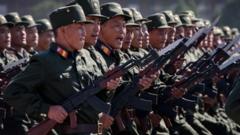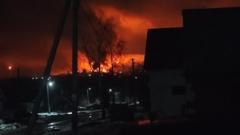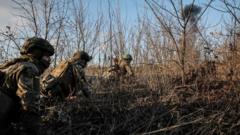Recent reports and satellite imagery confirm that Russia is actively withdrawing military assets from Tartous, a pivotal base for operations in the region, amid changing political dynamics in Damascus.
Russia's Military Withdrawal from Syria Gains Pace: Tartous Port Evacuated

Russia's Military Withdrawal from Syria Gains Pace: Tartous Port Evacuated
Russia's pullout from its military presence in Syria is intensifying, with significant equipment removals from the crucial Tartous port.
As Russian military presence dwindles at Tartous, satellite images indicate the removal of various military vehicles and containers, raising questions about the future of Moscow's influence in Syria.
Russia has accelerated its military withdrawal from Syria, according to analysis and satellite imagery, highlighting significant reductions in military equipment stored at its key Tartous port. Following the recent ousting of the Assad regime, verified footage has shown columns of Russian military vehicles relocating to the ports, but fresh images revealed by Planet Labs indicate that a substantial amount of equipment has since been removed.
Russian officials have reportedly engaged in direct talks with the newly appointed Syrian government, amidst speculations that the latter has canceled Russia's leasing agreement for the port. Historically, Tartous has served as a strategic base for the Russian military, offering vital refueling and resupply capabilities. The cessation of naval operations at the port following the regime change raises concerns about Russia's future military foothold in the area.
Despite official statements from the Kremlin expressing intentions to secure a continued presence at the base, evidence suggests a strategic withdrawal of valuable military assets. Reports indicate that Russian hardware has been relocated not only from Tartous but also from the nearby Hmeimim airbase.
Shipping data confirms that Russian vessels, Sparta and Sparta II, docked at Tartous in January, facilitating the transportation of military vehicles. As of early this week, both vessels have left the port, further corroborating the ongoing withdrawal. Observers share that the sudden disappearance of military assets and the deactivation of tracking devices on these vessels breed suspicion about the intent behind the movements.
Experts speculate on the ships' potential destinations, with possibilities ranging from Libya, where Russia supports local warlords, to back home in Russia for redeployment in the ongoing conflict in Ukraine.
Dmitry Gorenburg, a security analyst, concludes that the observed withdrawals signal the imminent end of Russia's military presence at Tartous, indicating a potential reshuffling of their strategy in response to shifting power dynamics in the region.
Russia has accelerated its military withdrawal from Syria, according to analysis and satellite imagery, highlighting significant reductions in military equipment stored at its key Tartous port. Following the recent ousting of the Assad regime, verified footage has shown columns of Russian military vehicles relocating to the ports, but fresh images revealed by Planet Labs indicate that a substantial amount of equipment has since been removed.
Russian officials have reportedly engaged in direct talks with the newly appointed Syrian government, amidst speculations that the latter has canceled Russia's leasing agreement for the port. Historically, Tartous has served as a strategic base for the Russian military, offering vital refueling and resupply capabilities. The cessation of naval operations at the port following the regime change raises concerns about Russia's future military foothold in the area.
Despite official statements from the Kremlin expressing intentions to secure a continued presence at the base, evidence suggests a strategic withdrawal of valuable military assets. Reports indicate that Russian hardware has been relocated not only from Tartous but also from the nearby Hmeimim airbase.
Shipping data confirms that Russian vessels, Sparta and Sparta II, docked at Tartous in January, facilitating the transportation of military vehicles. As of early this week, both vessels have left the port, further corroborating the ongoing withdrawal. Observers share that the sudden disappearance of military assets and the deactivation of tracking devices on these vessels breed suspicion about the intent behind the movements.
Experts speculate on the ships' potential destinations, with possibilities ranging from Libya, where Russia supports local warlords, to back home in Russia for redeployment in the ongoing conflict in Ukraine.
Dmitry Gorenburg, a security analyst, concludes that the observed withdrawals signal the imminent end of Russia's military presence at Tartous, indicating a potential reshuffling of their strategy in response to shifting power dynamics in the region.




















